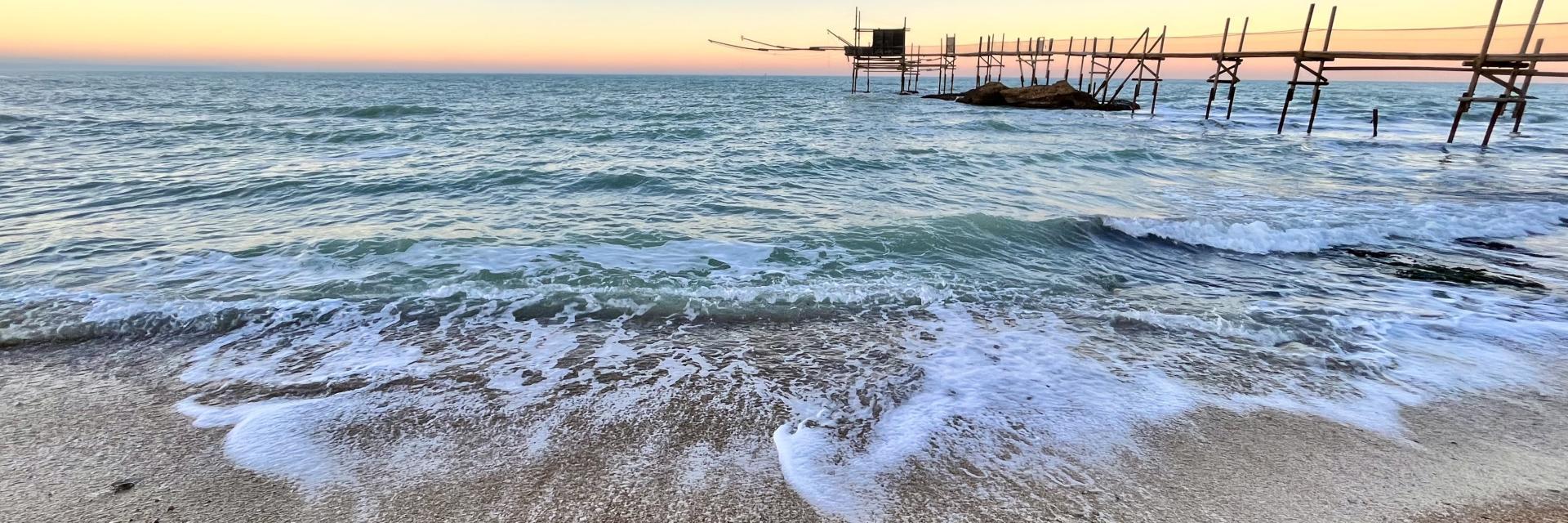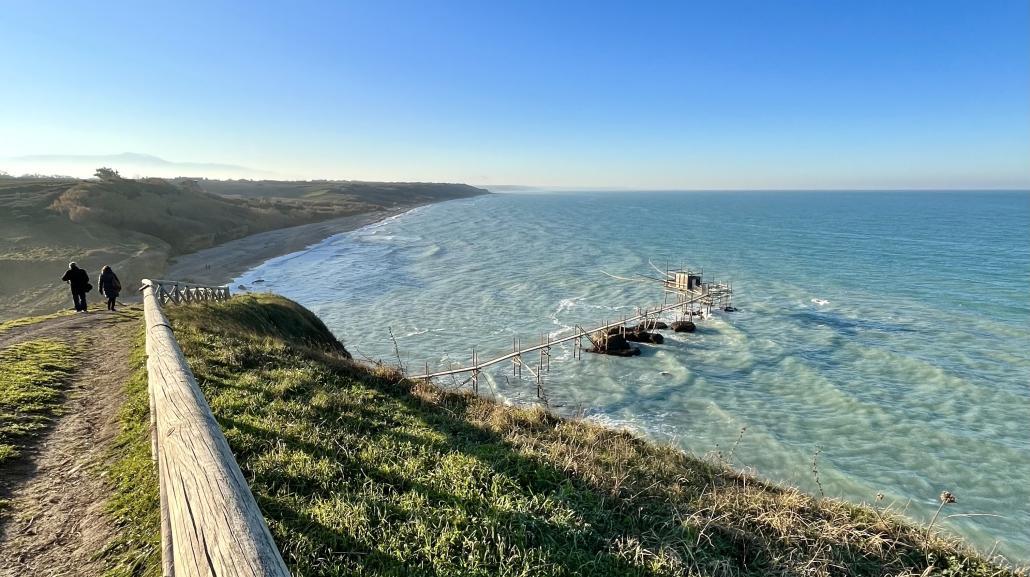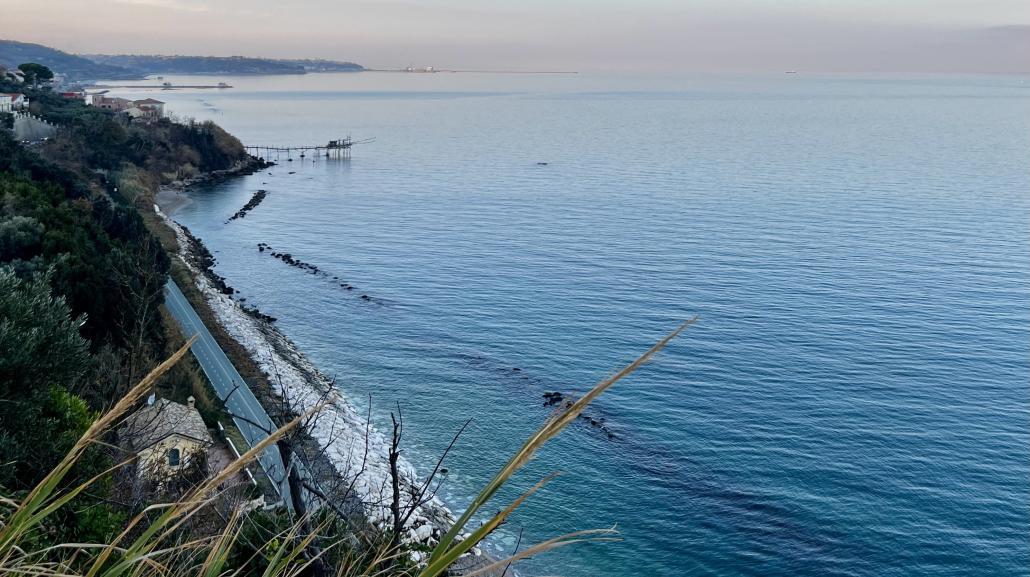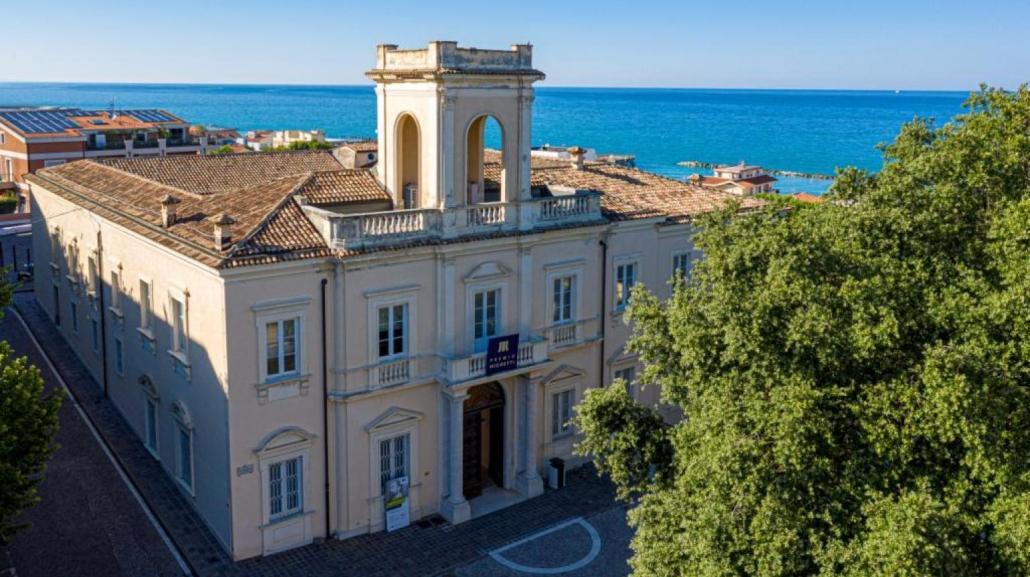48 Hours on Abruzzo’s Most Renowned Coast
In 1983, Loredana Bertè sang, "The sea in winter is just a black-and-white movie seen on TV," but the scenery offered by the Costa dei Trabocchi is, on the contrary, rich in colors and shades—a vibrant landscape where the blue of the Adriatic alternates with the yellow and orange of citrus fruits and the green of olive trees. Even the bare vineyards add their own chromatic touch. And then there are the sunsets, which in winter are particularly beautiful and generous, with warm and vivid tones.
The itinerary we suggest by car starts from Punta Aderci in Vasto and reaches Francavilla al Mare and Miglianico. For those who want to cycle, much of the suggested route is crossed by the Via Verde, a cycle-pedestrian path that runs along the Costa dei Trabocchi. The website [www.reteciclabiletrabocchi.it](http://www.reteciclabiletrabocchi.it) provides all the routes that can be cycled along the coast, even in winter.
DAY ONE
4:00 PM - Walk at Punta Aderci
The Punta Aderci Nature Reserve represents one of the most beautiful and evocative stretches of coastline in Abruzzo: a succession of sandy beaches and pebble beaches, high cliffs and rocky outcrops, agricultural landscapes and Mediterranean scrub, green and blue hues of a unique stretch of sea. Upon reaching the promontory on foot, you can admire a sunset that, with its colors, outlines the profiles of the mountains of three national parks: the Maiella, the Gran Sasso-Laga, and the Sibillini Mountains.
5:30 PM - In the Historic Center of Vasto
Formerly known as Histonium, Vasto has very ancient origins. Legend has it that it was founded by Diomedes after the Trojan War. An early settlement, the Frentano, stood on nearby Punta Penna, while with the arrival of the Romans, the city took shape in what is now Vasto. First conquered by the Lombards and then by the Franks, it became "Guasto d’Aimone." From 1496 and for more than three centuries, the d'Avalos family linked their name to the history of the city.
Strolling through the historic center is a journey back in time, following an ideal itinerary that goes from the mosaics of the Archaeological Park of the Roman Baths to the medieval period with the imposing Caldora fortifications and precious churches, to the majestic Palazzo d'Avalos with its charming Neapolitan Garden. Nearby, on the eastern walkway, is the Loggia Amblingh, a balcony suspended over fields of olive trees, orange trees, and orchards that descend towards the sea.
8:30 PM - Starred Dinner at Al Metrò
Head south to San Salvo Marina to enjoy dinner at Al Metrò, a Michelin-starred restaurant run by brothers Nicola and Antonio Fossaceca, in the kitchen and dining room, respectively.
The cuisine is flavored by the Adriatic, with a focus on the best fish, complemented by other meticulously selected seasonal local products such as vegetables, fruits, aromatic herbs, and spices. The menu offers three options: contemporary, our tradition, and the small menu. The mullet in express skapece, an ancient preparation from this region, rediscovered and enhanced with a contemporary and creative touch by Nicola Fossaceca, is a must-try. Reservations required ([restaurantealmetro.it](http://www.restaurantealmetro.it)).
Shopping Tips: What to Buy Typical of the Region
Extra virgin olive oil: Azienda Agricola La Selvotta in Vasto. Wine and hospitality in the winery: Fontefico and Jasci & Marchesani in Vasto. Caciocavallo and scamorza: Fratelli La Bruna in Vasto Caseificio 3 Monti in San Salvo Marina (you can also buy Ventricina del Vastese from producers like Ventricina&Dintorni, La Genuina, Il Biancospino, Bontà Di Fiore). Tomato mezzotempo preserves: Azienda Agricola Travaglini in San Salvo.
DAY TWO
9:30 AM - English Cemetery in Torino di Sangro
A short distance from the sea, crossing the lush vegetation of the Holm oak forest, the Regional Nature Reserve that extends over 180 hectares south of the mouth of the Sangro River, you can reach the English Cemetery of Torino di Sangro—a vast green meadow dotted with white crosses where 2,617 soldiers from British Commonwealth territories rest, who fell in World War II during the battle to break the Gustav Line at the Sangro River in November-December 1943.
10:30 AM - The Abbey of San Giovanni In Venere
Perched on a hill in a landscape rich in centuries-old olive trees, the Abbey overlooks the Costa dei Trabocchi with an exclusive view. The first nucleus was built by Benedictine monks between the 6th and 7th centuries AD on the remains of an ancient pagan temple dedicated to Venus. The current construction is attributed to Abbot Oderisio II (1155-1204), who is buried in the sarcophagus embedded in the main facade. Here you can admire the apses that resemble towers, the white portal, the majestic naves, the intimate crypt, the fragrant cloister, and an impressive panorama of the rugged Adriatic coast.
11:30 AM - The Vallevò Market and Trabocco Punta Tufano
In winter, along the Costa dei Trabocchi, the blue of the sea mixes with the vibrant hues of the orange groves—stretches of citrus fruits that become an integral part of a truly suggestive scene. The coastline between Vasto and Ortona, dominated by trabocchi, is also famous for its oranges, particularly the cetrangolo, a bitter orange distinguished by its branches covered with large thorns, a winged petiole, and the intense aroma emitted by its leaves, flowers, and fleshy, seed-rich fruits. In Vallevò, stock up on citrus fruits at one of the small, colorful shops where derived products such as jams are also sold. Here you can visit, by reservation and verification of availability, the Trabocco Punta Tufano ([traboccopuntatufano.eu](http://www.traboccopuntatufano.eu)): the owner, Rinaldo Verì, will tell you the history of these places, the trabocchi, and even the "sea monster" that ran aground near the current trabocco in 1960.
12:30 PM - In the Places That Inspired Gabriele D’Annunzio
Traveling north towards San Vito, make a stop at the Dannunziano Promontory: an exclusive viewpoint over a pebble beach and crystal-clear water. Behind you is the Dannunziano Hermitage, the residence where D’Annunzio spent a period of his life with Barbara Leoni. Then, descend along the nearby path to the Trabocco del Turchino, which the Vate describes in one of his most famous works, "The Triumph of Death." Let yourself be intoxicated by the pleasant salty breeze and enjoy this incredible corner of the Costa dei Trabocchi.
1:30 PM - Lunch in San Vito Chietino
For lunch, stop in San Vito Chietino, where you can enjoy the seafood cuisine of the trabocchi coast in one of the many local taverns and/or restaurants, which focus on local ingredients and seasonal offerings. Among these are SottoSale, L’Angolino da Filippo, Essenza Cucina di Mare, and Trattoria Adriatica. If you prefer dishes that combine haute cuisine and creativity, La Bottega Culinaria Biologica is your place. To digest your lunch, you can walk a stretch of the Via Verde, a cycle-pedestrian path that runs along the Costa dei Trabocchi. Don't leave San Vito without trying the typical celli pieni: crunchy tarallucci made with wine and extra virgin olive oil and filled with almonds and grape jam.
4:00 PM - The Canadian Cemetery and Punta Acquabella
Make a stop at the secluded and quiet Canadian Cemetery in the locality of San Donato, where soldiers of the British Commonwealth, mostly Canadians, who fell in World War II, are buried. About 300 meters from the cemetery, taking the Batteria municipal road, you can reach Punta Acquabella, a beach characterized by sand and pebbles and particularly clear water.
5:30 PM - Ortona, a Seaside Town
Visit the characteristic streets of the historic center, the panoramic eastern walkway, and the majestic Aragonese Castle, a 16th-century fortress overlooking the sea. Ortona, besides the sea and splendid beaches, is associated with the Apostle Thomas and his "path," Francesco Paolo Tosti, a 19th-century composer, the Second World War, when it experienced one of the darkest periods in its history, and the beauty of a landscape dominated by vineyards. Here you can enjoy the nevole—delicate wafer cones made with cooked must.
8:30 PM - A Gourmet Pizza in Arielli
Just a 15-minute drive from Ortona, reach Arielli, home to Pizzeria Giangi, one of Italy's best according to the 50 Top Pizza and Gambero Rosso guides. Pizzaiolo Gianluigi Di Vincenzo has distinguished himself in recent years for doughs made exclusively with whole Italian grain flours and the use of local and seasonal ingredients. The result is a light, highly digestible pizza offered
in various versions: classic, crispy, soft-pan, and stuffed. There is a varied selection of wines and beers. Reservations recommended ([www.giangipizza.it](http://www.giangipizza.it)).
Shopping Tips: What to Buy Typical of the Region
Extra virgin olive oil: Ursini in Fossacesia. Wine and hospitality in the winery: Cantina Mucci in Torino di Sangro, Cantina Frentana in Rocca San Giovanni, Tommaso Olivastri in San Vito Chietino, Inverso Vini, and Dora Sarchese in Ortona. Caciotta Frentana and stretched-curd cheeses: Azienda Agricola Fonte dei Sapori in Fossacesia. Citrus fruits from the Costa dei Trabocchi and jams: Azienda Agricola Caravaggio Donato in Fossacesia, La Bottega del Trabocco di Punta Tufano in Vallevò (Rocca San Giovanni). Celli pieni: Pasticceria Iezzi Rossana in San Vito Chietino. Nevole: Pasticceria Cantelmi in Ortona.
DAY THREE
9:30 AM - The Michetti Convent and the MuMi: A Walk in Francavilla al Mare
Between the late 19th and early 20th centuries, a cultural movement called the Cenáculo Michettiano was born in Abruzzo. Francesco Paolo Michetti, a visionary painter, created in Francavilla al Mare, in the ancient Franciscan convent of Santa Maria del Gesù, a meeting place for artists and writers. Important figures from the cultural scene of the time stayed in this convent, including the poet Gabriele d'Annunzio, sculptor Costantino Barbella, composer Francesco Paolo Tosti, painter Basilio Cascella, and intellectuals Edoardo Scarfoglio and Matilde Serao. Visit the Michetti Convent and then continue on foot to Piazza San Domenico, where in the old town hall and convent is the MuMi, the Michetti Museum. The museum space houses, in the basement, the two large and famous canvases by the Abruzzese painter, Le serpi and Gli storpi.
The Michetti Convent is open by reservation: email conventomichetticultura@gmail.com Tel. 33863 41119.
The MuMi is open from Tuesday to Sunday. For info: email info@fondazionemichetti.it Tel. 085 4913719 - 085 4920276.
11:00 AM - Historic Tasting in Miglianico
Leave the Adriatic and in less than a quarter of an hour by car, you’ll be in Miglianico for a wine tasting at Ciavolich. Although the property in Loreto Aprutino represents the company's new headquarters, the history of the estate is rooted in Miglianico, where it still preserves the old palace and the old cellar. At the helm of this historic Abruzzese wine estate today is Chiara Ciavolich, who with foresight, dedication, and tenacity has given new impetus to the company. The estate covers about thirty hectares; the main grape varieties are Montepulciano d'Abruzzo, Trebbiano Abruzzese, and Pecorino, cultivated in pergola and rows in the renowned territory of Loreto Aprutino and, to a lesser extent, in Pianella. The winery works with spontaneous selected and indigenous fermentations. There are various aging possibilities: steel, wood, concrete, and amphora. The winery experience is offered in various solutions for the company's different locations. In Miglianico, a tasting is offered that traces the history of the Ciavolich family, with a visit to the old cellar and the tasting of 4 wines accompanied by typical local products. Reservations are required ([www.ciavolich.com/store/degustazioni/](http://www.ciavolich.com/store/degustazioni/)).
1:30 PM - Sunday Lunch at Agriturismo Campo Letizia
Just outside the town of Miglianico, surrounded by vineyards and olive groves, Nicola Piattelli will welcome you to his agriturismo in a pleasant and relaxing environment to enjoy traditional-style local cuisine revisited. The pride of the agriturismo is its organic garden and the cultivation of ancient grains. The property also has a few rooms. Reservations required ([www.campoletizia.it](http://www.campoletizia.it)).
Shopping Tips: What to Buy Typical of the Region
Extra virgin olive oil: Frantoio Tiberio in Tollo. Wine and hospitality in the winery: Feudo Antico in Tollo, Cantina Rapino in Francavilla al Mare, Pasetti in Francavilla al Mare, Tenuta i Fauri in Ari. Seasonal fruits and vegetables, Pera d'Abruzzo tomato preserves: Azienda Agricola Fratelli Nicolini in Francavilla al Mare.
Fuente: https://saporiabruzzo.it/consigli/il-mare-dinverno-itinerario-lungo-la-costa-dei-trabocchi-21645




